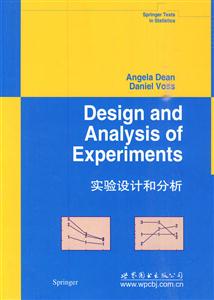-
>
宇宙、量子和人類心靈
-
>
氣候文明史
-
>
南極100天
-
>
考研數學專題練1200題
-
>
希格斯:“上帝粒子”的發明與發現
-
>
神農架疊層石:10多億年前遠古海洋微生物建造的大堡礁
-
>
聲音簡史
實驗設計和分析 版權信息
- ISBN:9787510005619
- 條形碼:9787510005619 ; 978-7-5100-0561-9
- 裝幀:一般膠版紙
- 冊數:暫無
- 重量:暫無
- 所屬分類:>>
實驗設計和分析 本書特色
本書旨在講述數據調查和統計分析中運用的重要方法,實驗設計和分析。書中詳細介紹了實驗設計過程以及正態分布數據的分析方法,重點強調需要考慮有實際背景和具體目標的實驗設計和分析。為了保證數據的可靠性和真實性,書中幾乎所有的數據或來自實際數據、或統計專業的學生取得、或應用科學領域、或者科學文獻中已經公布的。本書從實驗設計和分析的基本原理和技巧出發,繼而講述了一攬子的實驗設計、處理對比估計和方差分析。這些基本知識列舉了大量的應用。每章末都附有大量的學習統計軟件SAS的知識,然而書中的知識可以和任何統計軟件結合。
實驗設計和分析 內容簡介
principles and techniques、design: basic principles and techniques、the art of experimentation、replication、blocking、randomization、analysis: basic principles and techniques、planning experiments、a checklist for planning experiments、real experiment——cotton-spinning experiment等等。
實驗設計和分析 目錄
1. principles and techniques
1.1. design: basic principles and techniques
1.1.1. the art of experimentation
1.1.2. replication
1.1.3. blocking
1.1.4. randomization
1.2. analysis: basic principles and techniques
2. planning experiments
2.1. introduction
2.2. a checklist for planning experiments
2.3. a real experiment——cotton-spinning experiment
2.4. some standard experimental designs
2.4.1. completely randomized designs
2.4.2. block designs
2.4.3. designs with two or more blocking factors
2.4.4. split-plot designs
2.5. more real experiments
2.5.1. soap experiment
2.5.2. battery experiment
2.5.3. cake-baking experiment
exercises
3. designs with one source of variation
3.1. introduction
3.2. randomization
3.3. model for a completely randomized design
3.4. estimation of parameters
3.4.1. estimable functions of parameters
3.4.2. notation
3.4.3. obtaining least squares estimates
3.4.4. properties of least squares estimators
3.4.5. estimation ofo2
3.4.6. confidence bound for ~r2
3.5. one-way analysis of variance
3.5.1. testing equality of treatment effects
3.5.2. use of p-values
3.6. sample sizes
3.6.1. expected mean squares for treatments
3.6.2. sample sizes using power of a test
3.7. a real experiment——-soap experiment, continued
3.7.1. checklist, continued
3.7.2. data collection and analysis
3.7.3. discussion by the experimenter
3.7.4. further observations by the experimenter
3.8. using sas software
3.8.1. randomization
3.8.2. analysis of variance
exercises
4. inferences for contrasts and treatment means
4.1. introduction
4.2. contrasts
4.2.1. pairwise comparisons
4.2.2. treatment versus control
4.2.3. difference of averages
4.2.4. trends
4.3. individual contrasts and treatment means
4.3.1. confidence interval for a single contrast
4.3.2. confidence interval for a single treatment mean
4.3.3. hypothesis test for a single contrast or treatment mean
4.4. methods of multiple comparisons
4.4.1. multiple confidence intervals
4.4.2. bonferroni method for preplanned comparisons
4.4.3. scheff6 method of multiple comparisons
4.4.4. tukey method for all pairwise comparisons
4.4.5. dunnett method for treatment-versus-control comparisons
4.4.6. hsu method for multiple comparisons with the best reatment
4.4.7. combination of methods
4.4.8. methods not controlling experimentwise error rate
4.5. sample sizes
4.6. using sas software
4.6.1. inferences on individual contrasts
4.6.2. multiple comparisons
exercises
5. checking model assumptions
5.1. introduction
5.2. strategy for checking model assumptions
5.2.1. residuals
5.2.2. residual plots
5.3. checking the fit of the model
5.4. checking for outliers
5.5. checking independence of the error terms
5.6. checking the equal variance assumption
5.6.1. detection of unequal variances
5.6.2. data transformations to equalize variances
5.6.3. analysis with unequal error variances
5.7. checking the normality assumption
5.8. using sas software
5.8.1. using sas to generate residual plots
5.8.2. transforming the data
exercises
6. experiments with two crossed treatment factors
7. several crossed treatment factors
8. polynomial regression
9. analysis of covariance
10. complete block designs
11. incomplete block designs
12. designs with two blocking factors
13. confounded two-level factorial experiments
14. confounding in general factorial experiments
15. fractional factorial experiments
16. esponse surface methodology
17. andom effects and variance components
18. estde models
19. plit-plot designs
a. ables
bibliography
index of authors
index of experiments
index of subjects
實驗設計和分析 節選
《實驗設計和分析》主要內容包括:Principles and Techniques、Design: Basic Principles and Techniques、The Art of Experimentation、Replication、Blocking、Randomization、Analysis: Basic Principles and Techniques、Planning Experiments、A Checklist for Planning Experiments、Real Experiment——Cotton-Spinning Experiment等等。
實驗設計和分析 相關資料
插圖:In the analysis of data, it is desirable to provide both graphical and statistical analyses. Plotsthat illustrate the relative responses of the factor settings under study allow the experimenterto gain a feel for the practical implications of the statistical results and to communicateeffectively the results of the experiment to others. In addition, data plots allow the proposedmodel to be checked and aid in the identification of unusual observations, as discussed inChapter 5. Statistical analysis quantifies the relative responses of the factors, thus clarifyingconclusions that might be misleading or not at all apparent in plots of the data.The purpose of an experiment can range from exploratory (discovering new importantsources of variability) to confirmatory (confirming that previously discovered sources ofvariability are sufficiently major to warrant further study), and the philosophy of the analysisdepends on the purpose of the experiment. In the early stages of experimentation the analysismay be exploratory, and one would plot and analyze the data in any way that assists in theidentification of important sources of variation. In later stages of experimentation, analysisis usually confirmatory in nature. A mathematical model of the response is postulated andhypotheses are tested and confidence intervals are calculated. In this book, we use linear models to model our response and the methodofleast squaresfor obtaining estimates of the parameters in the model. These are described in Chapter 3.Our models include random "error variables" that encompass all the sources of variabilitynot explicity present in the model. We operate under the assumption that the error termsare normally distributed. However, most of the procedures in this book are generally fairlyrobust to nonnormality, provided that there are no extreme observations among the data. It is rare nowadays for experiment
- >
上帝之肋:男人的真實旅程
- >
山海經
- >
龍榆生:詞曲概論/大家小書
- >
月亮與六便士
- >
羅庸西南聯大授課錄
- >
推拿
- >
唐代進士錄
- >
姑媽的寶刀
















